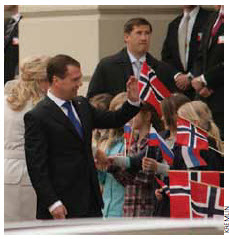
By Else Berit Eikeland
In September 2010, Norway and Russia signed the treaty on maritime delimitation and co-operation in the Barents Sea and the Arctic Ocean. The treaty was an historic milestone. It resolved what for several decades had remained the most important outstanding issue between Norway and Russia: the maritime boundary between the two countries. The treaty sent an important signal to the rest of the world: the Arctic is a peaceful region where any issues that arise are resolved in accordance with international law. It reflects the parties’ active role and responsibility, as coastal states, for securing stability and strengthening co-operation in the Arctic Ocean.
The treaty marks the end of a long process. Negotiations had been ongoing since the ’70s. The Russian position had been that the delimitation line should follow a sector line running roughly along longitude 32 degrees northwards from the Russian coastline. Norway’s position had been a median line, every point of which is equidistant from the nearest point on the Norwegian and Russian coastlines. The different positions resulted in an area of overlapping claims of roughly 175,000 square kilometres that was referred to as the “Grey Zone.” Building on international jurisprudence, an agreement, which takes into account the geographical particularities of the area, was found. Today, the Grey Zone is history.
The treaty, however, is more than a border agreement. It also strengthens the co-operation with Russia, which is one of Norway’s top foreign policy priorities as part of our High North Policy.
The treaty ensures the continuation of the excellent bilateral co-operation in fisheries and does not adversely affect the opportunities for Norwegian and Russian fishermen to fish in the Barents Sea. The Norwegian-Russian Joint Fisheries Commission continues to play a key role in the management of the fisheries resources in the Barents Sea, which today has the most sustainable fish stocks in the world.
Since the 1980s, Norway and Russia had agreed not to carry out exploration and exploitation of oil and gas resources in the Grey Zone. This moratorium came to an end when the treaty came into force. Possible hydrocarbon resources in the area were not an issue in the negotiations. However, the treaty also contains provisions on transboundary oil and gas deposits. These include provisions on the parties’ obligation to co-operate on the exploitation of any such transboundary deposits that are discovered. These detailed provisions are intended to ensure that the deposits are exploited in a cost-effective and rational manner, and that the resources are shared in accordance with the agreement between the parties.
Neither of the parties can start exploitation of a transboundary deposit without first reaching agreement with the other party. Even if they agree to exploit the field as a unit, an approach known as unitization, the parties continue to have jurisdiction over their respective sides of the delimitation line. Norway has previously entered into a number of agreements involving unitization; most of these concern petroleum resources in the North Sea.
The provisions of the exploitation on any transboundary petroleum deposits contained in the treaty on maritime delimitation in the Barents Sea and the Arctic Ocean are modelled on established practice under international law.
The discovery of commercially viable transboundary deposits could create considerable potential for cooperation with Russia. The treaty on maritime delimitation thus opens new possibilities for the petroleum sector and for Norwegian-Russian cooperation in this sector. The treaty also paves the way for increased commercial cooperation in the Barents Sea, including exchange of experience and technology. It is essential to ensure that the exploitation of petroleum resources in the Barents Sea is able to coexist with other industries in the area, such as fisheries. Ensuring high standards of health, safety and environmental safeguards will be a key priority.
At the Arctic Ocean conference in Ilulissat, Greenland in 2008, the five coastal states bordering the Arctic Ocean (Canada, Denmark/Greenland, Russia, the U.S. and Norway) declared that the law of the sea is the applicable legal framework for our region. The agreement between Norway and Russia puts these words into practice and confirms that in the high North, there’s low tension.
Else Berit Eikeland was Norway’s ambassador to Canada until August 2012. She is now her foreign ministry’s senior Arctic official, responsible for Arctic policy and the Arctic Council.





